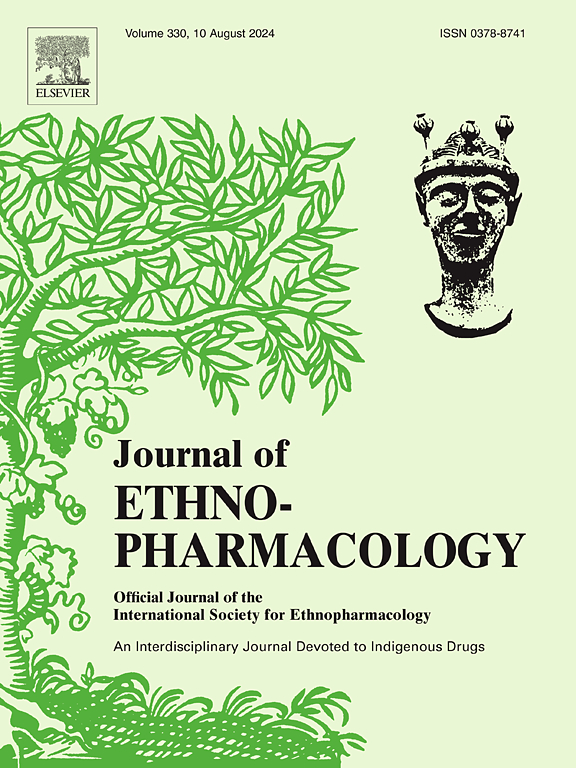Xiao-xu-ming decoction improved synaptic damage after acute cerebral ischemia and reperfusion via JAK2/STAT3 pathway in rats
IF 4.8
2区 医学
Q1 CHEMISTRY, MEDICINAL
引用次数: 0
Abstract
Ethnopharmacological relevance
Ischemic stroke is an important cause of death and disability worldwide. Xiao-xu-ming Decoction (XXMD) is a classic prescription for the treatment of stroke patients, which has been widely used in China and has significant therapeutic effect, but the therapeutic target and mechanism are still unclear.
Aim of the study
The current study aimed to investigate temporal alternation of synaptic damage and the protective effects of XXMD on synaptic damage following cerebral ischemia and reperfusion in vivo.
Materials and methods
Adult male Sprague-Dawley (SD) rats subjected to 90 min of middle cerebral artery occlusion (MCAO) and subsequent reperfusion at various time points. Neurobehavioral function was assessed using modified neurological severity scores (mNSS), while pro-inflammatory cytokine levels were measured using ELISA kits. Histological assessment involved silver staining and Luxol Fast Blue (LFB) staining, and the ultrastructural alterations in neurons and synapses were examined using a transmission electron microscope (TEM). Golgi-cox staining was used to evaluate the density of dendritic spines. Levels of synapse-related proteins were quantified via immunofluorescence staining and Western blotting. Additionally, JAK2/STAT3 pathway related protein levels were assessed using Western blotting. In the second part, the rats were randomly divided into sham operation group, 24 h of reperfusion group, and XXMD group. The ultrastructural alterations and dendrite spine density of synapses were observed by TEM and Golgi-Cox staining respectively, and the expression levels of SYN, PSD95, GAP43, p-JAK2 and p-STAT3 were evaluated by WB.
Results
Findings included deteriorated neurobehavioral function, increased release of IL-6, IL-1β, and TNFα, and time-dependent neuronal and synaptic damages during the initial phase of ischemia and reperfusion. At the ultrastructural level, neurons and synapses exhibited structural failure in the peri-infarct cortex. In addition, golgi-cox staining showed dendritic density in ischemic cortex significantly reduced after cerebral ischemia and reperfusion. Moreover, significant reductions in SYN, PSD95, and GAP43 expression levels, along with increases in p-JAK2 and p-STAT3 expression levels, were observed after cerebral ischemia and reperfusion. Meantime, XXMD significantly reduced synaptic impairment and up-regulated SYN, GAP43, PSD95 expression and down-regulated phosphorylation expression of JAK2 and STAT3 following MCAO and 24 h of reperfusion.
Conclusion
Collectively, these results indicates XXMD may play a neuroprotective role in reducing synaptic damage via JAK2/STAT3 signaling pathway.

消须明汤通过JAK2/STAT3通路改善大鼠急性脑缺血再灌注后突触损伤。
民族药理学相关性:缺血性中风是世界范围内死亡和残疾的重要原因。小虚明汤(XXMD)是治疗脑卒中患者的经典方剂,在国内得到广泛应用,疗效显著,但其治疗靶点和作用机制尚不清楚。研究目的:本研究旨在探讨脑缺血再灌注后突触损伤的时间变化及XXMD对突触损伤的保护作用。材料与方法:成年雄性SD大鼠在不同时间点进行90分钟大脑中动脉闭塞(MCAO)后再灌注。采用改良神经系统严重程度评分(mNSS)评估神经行为功能,采用ELISA试剂盒检测促炎细胞因子水平。组织学观察采用银染色和Luxol Fast Blue (LFB)染色,透射电镜(TEM)观察神经元和突触超微结构变化。采用高尔基-考克斯染色法测定树突棘的密度。免疫荧光染色和Western blotting检测突触相关蛋白水平。此外,使用Western blotting评估JAK2/STAT3通路相关蛋白水平。第二部分将大鼠随机分为假手术组、24小时再灌注组和XXMD组。透射电镜(TEM)和高尔基-考克斯染色(Golgi-Cox)分别观察突触超微结构变化和树突棘密度,WB检测SYN、PSD95、GAP43、p-JAK2和p-STAT3的表达水平。结果:缺血再灌注初期神经行为功能恶化,IL-6、IL-1β和TNFα释放增加,神经元和突触损伤呈时间依赖性。在超微结构水平上,神经元和突触在梗死周围皮层表现出结构破坏。此外,高尔基-考克斯染色显示,脑缺血再灌注后,缺血皮质的树突密度明显降低。此外,脑缺血再灌注后,SYN、PSD95和GAP43的表达水平显著降低,p-JAK2和p-STAT3的表达水平显著升高。同时,XXMD显著降低MCAO和再灌注24小时后突触损伤,下调SYN、GAP43、PSD95表达和JAK2、STAT3磷酸化表达。结论:综上所述,XXMD可能通过JAK2/STAT3信号通路,在减少突触损伤中发挥神经保护作用。
本文章由计算机程序翻译,如有差异,请以英文原文为准。
求助全文
约1分钟内获得全文
求助全文
来源期刊

Journal of ethnopharmacology
医学-全科医学与补充医学
CiteScore
10.30
自引率
5.60%
发文量
967
审稿时长
77 days
期刊介绍:
The Journal of Ethnopharmacology is dedicated to the exchange of information and understandings about people''s use of plants, fungi, animals, microorganisms and minerals and their biological and pharmacological effects based on the principles established through international conventions. Early people confronted with illness and disease, discovered a wealth of useful therapeutic agents in the plant and animal kingdoms. The empirical knowledge of these medicinal substances and their toxic potential was passed on by oral tradition and sometimes recorded in herbals and other texts on materia medica. Many valuable drugs of today (e.g., atropine, ephedrine, tubocurarine, digoxin, reserpine) came into use through the study of indigenous remedies. Chemists continue to use plant-derived drugs (e.g., morphine, taxol, physostigmine, quinidine, emetine) as prototypes in their attempts to develop more effective and less toxic medicinals.
 求助内容:
求助内容: 应助结果提醒方式:
应助结果提醒方式:


